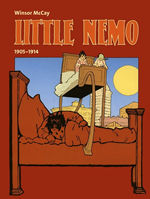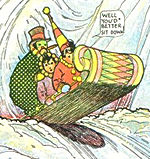
 Writer/Artist: Winsor McCay
Writer/Artist: Winsor McCay
Collecting the complete LITTLE NEMO IN SLUMBERLAND and IN THE LAND OF WONDERFUL DREAMS newspaper strips.
Price: $39.99 (Hardback)
Publisher: Taschen/Evergreen
ISBN: 3-8228-6300-9
Winsor McCay was a man of many talents, almost all of which were underappreciated during his lifetime thanks to William Randolph Hearst. From 1904 to 1911, McCay created three weekly strips for the New York Herald; DREAMS OF THE RAREBIT FIEND, A PILGRIM'S PROGRESS and of course LITTLE NEMO.
At the same time, McCay was a popular fixture on the vaudeville circuit, doing chalk drawings while talking with the audience; many of his strips were drawn in his dressing room between acts. While all this was going on, McCay still found time to work on a Broadway show of NEMO that premiered in 1908, and most importantly, became one of the pioneers of the animation industry with such films as GERTIE THE DINOSAUR - films that, incidentally, he drew every frame of himself.
Unfortunately, the Herald was unwilling to give McCay time off to perform in Europe, and as a result, McCay jumped ship to join rival paper The American in 1911. While NEMO continued under the new title of IN THE LAND OF WONDERFUL DREAMS, the strip suffered from decreased production values, and McCay was eventually made to give up strip work for editorial cartoons. In addition, Hearst helped thwart McCay's vaudeville career by discouraging proprietors from booking him, and eventually he made McCay sign a contract that prevented him from performing outside of New York City.
McCay finally left Hearst in 1924 and attempted a revival of NEMO back at the Herald, but the strip only ran for two more years before disappearing for the last time. McCay, however, was allowed to purchase the rights to his characters for the sum of a dollar - a notable deal considering what many creators would go through in later years when trying to reclaim their characters.
For all the behind-the-scenes difficulties, though, LITTLE NEMO itself remains one of the most important and visually resplendent comic strips in the history of the medium; one whose power and influence remains astonishing even to this day.
Collections of the strip have gone in and out of print over the last several decades, but thanks to Evergreen's recent collection, LITTLE NEMO 1905-1914, all the strips from 1905 to 1914 are finally together in one affordable hardcover volume, allowing a new generation of readers to experience McCay's masterpiece.
 Like most strips of its era, LITTLE NEMO was a weekly Sunday comic that ran for a full newspaper page and relied on a standard formula for every strip. (McCay did similar things with his other strips, including LITTLE SAMMY SNEEZE, about a young child with hurricaine-causing allergies, and HUNGRY HENRIETTA, about a frequently upset young girl whose parents pacified her with foodstuffs).
Like most strips of its era, LITTLE NEMO was a weekly Sunday comic that ran for a full newspaper page and relied on a standard formula for every strip. (McCay did similar things with his other strips, including LITTLE SAMMY SNEEZE, about a young child with hurricaine-causing allergies, and HUNGRY HENRIETTA, about a frequently upset young girl whose parents pacified her with foodstuffs).
With NEMO, the titular child would find himself summoned every week to Slumberland by the daughter of Morpheus, Slumberland's great (and frequently befuddled) king, to act as the princess's playmate. Nemo's efforts to get to Slumberland were initally thrawted every time, first by his dreams spinning out of control, then by Flip, a mischievous clown and "outcast relative of the Dawn", who was never seen without a large cigar in his mouth.
Every time the dream started to get too chaotic (or, in some cases, when it was just starting to get good), Nemo would find himself awake in the last panel, often being shouted at by his parents for yelling in his sleep.
Eventually, Nemo made it to Slumberland and the princess, and more adventures ensued. Gradually, other characters were added to the strip, including Impie, a former member of a cannibal tribe, Dr Pill, a stuffy physician, and a red-haired boy who was never really named, but was made to suffer everything from being strapped into a spanking machine to being made to dance for monkeys.
The stories in LITTLE NEMO could go on for months at a time, and, to be honest, often made no sense whatsoever. A typical storyline could take the characters everywhere from Antartica to Mars, from Arabia to China, from a palace made of ice cream to an island filled with cannibals. Chaos could erupt at any minute, be it in the form of a barrage of cannonballs, Flip destroying everything by accident or, most typically, the laws of physics being turned sideways.
Just as Nemo was at the mercy of each strip's last-panel awakening, so were his dreams at the mercy of whatever fresh hell McCay could conceive of that week. Sometimes they would find themselves growing, other times shrinking, other times faced with the landscape around them changing at random.
They maintained a small degree of self-awareness about their situation - one strip found the hungry characters eating the strip's logo after they were locked out of a banquet hall, while another saw Nemo panicking as the world around him began to disappear because "the artist has forgotten to draw it!" One can only wonder if a young Grant Morrison ever read any reprints of these strips...
 The one constancy in NEMO's universe (aside from the aforementioned last panel), was the spectacular imagery. Along with his work in animation, McCay pioneered a variety of what would become cinematic techniques in his early strips, among them what would later become known as 'widescreen' effects. Strips would combine smaller panels with elaborate layouts and page designs (and, in the earlier strips, the Herald's expert colouring techniques), giving each strip a unique sense of scale and vividness.
The one constancy in NEMO's universe (aside from the aforementioned last panel), was the spectacular imagery. Along with his work in animation, McCay pioneered a variety of what would become cinematic techniques in his early strips, among them what would later become known as 'widescreen' effects. Strips would combine smaller panels with elaborate layouts and page designs (and, in the earlier strips, the Herald's expert colouring techniques), giving each strip a unique sense of scale and vividness.
Complimenting this were the unique and bizarre creations that populated McCay's landscapes, ranging from walking beds to giant airships to creatures that looked like the love children of Salavador Dali and Dr. Suess. McCay frequently employed the "giant animal" device in his stories, meaning Nemo and company were frequently terrorised by the likes of massive fish, apes, elephants, insects and in one case, a giant turkey. (Okay, two cases.)
McCay was also fond of incorporating elaborate pieces of architecture into the strip, be it the palace of Morpheus, the MC Escher-like Befuddle Hall, or even the cities of the waking world, which Nemo toured in his airship in one memorable storyline. It was a strip where anything could happen, and usually did.
LITTLE NEMO was hardly perfect. The dialogue often consisted of little more than the characters gawking at the strangeness around them, and the strips were filled with the racism typical of early twentieth-century comics (Asians, African-Americans and Native Americans are all likely to be offended by many of the strips contained in this collection). However, for all their flaws, these strips remain a powerful example of what the medium is capable of, and boast a level of imagination and visual creativity unequalled before or since.
Though many have tried, no one has ever been able to quite replicate the magic of the original strips. (A 1992 LITTLE NEMO animated feature that boasted Ray Bradbury and Moebius among its production credits only did an adequate job.) Yet the effect of LITTLE NEMO is felt heavily in today's comics; both Neil Gaiman and Alan Moore have created homages to it in their work (most notably in SANDMAN and PROMETHEA), and everything from Jack Kirby's hyperactive fantasies to Jim Woodring's nightmarish landscapes show the influence of Winsor McCay.
At forty dollars for a full-colour hardcover collecting over four hundred strips, LITTLE NEMO 1905-1914 is one of the best bargains in comics today, and it's an essential volume for anyone with an interest in the artistic potential of the medium. It deserves to be read, studied, and most of all enjoyed by a new audience, who can now fully appreciate the vivid dreams of Winsor McCay.

This article is Ideological Freeware. The author grants permission for its reproduction and redistribution by private individuals on condition that the author and source of the article are clearly shown, no charge is made, and the whole article is reproduced intact, including this notice.


